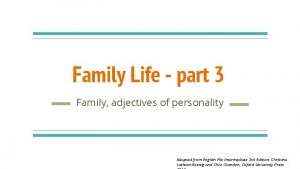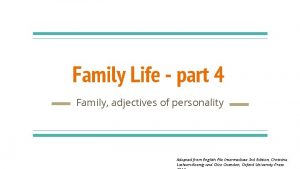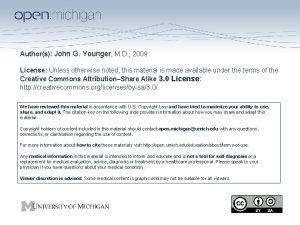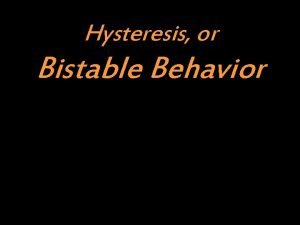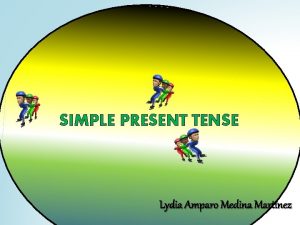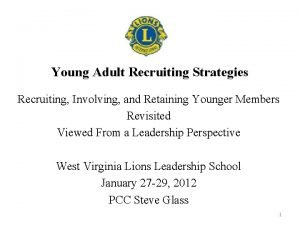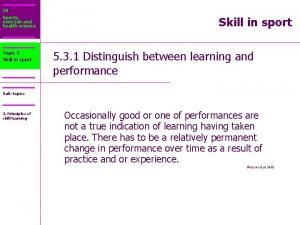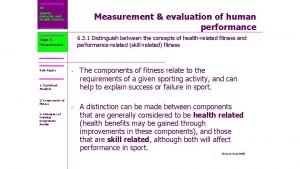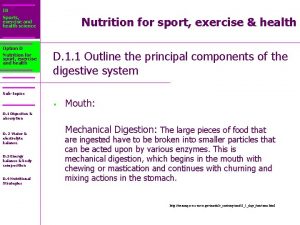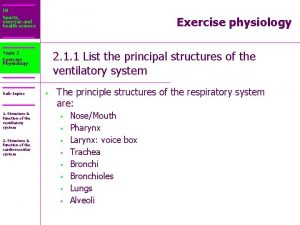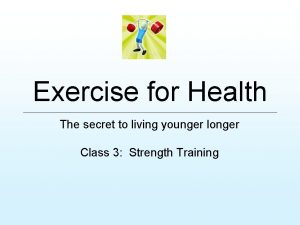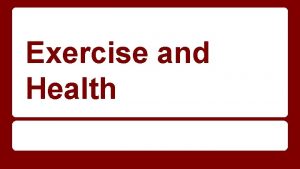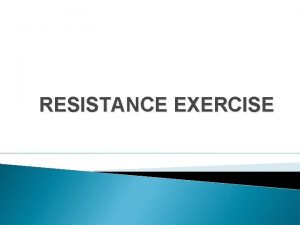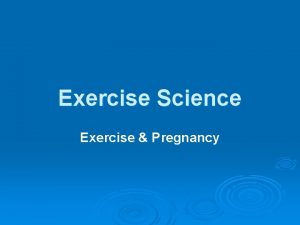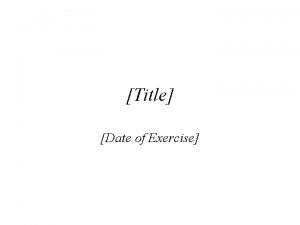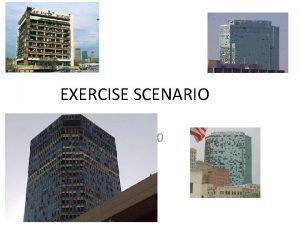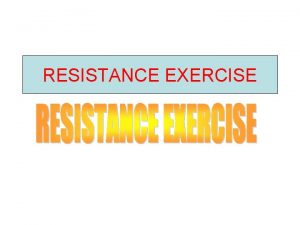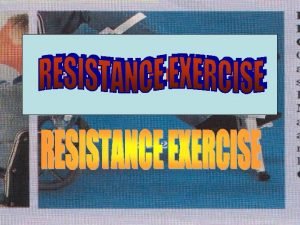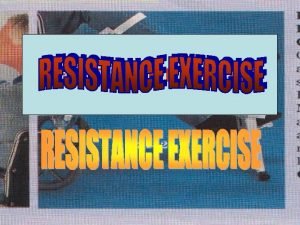Exercise for Health The Secret to Living Younger

























- Slides: 25

Exercise for Health The Secret to Living Younger Longer Class 4: Balance and putting it all together

What we’ll cover Balance Exercising with various health conditions Disease (e. g. cancer, cardiovascular disease, diabetes) Arthritis Overweight/obesity Osteoporosis Putting it all together and making it happen -strategies for success

Balance & Fall Prevention It ain’t easy!

We all fall

What is balance? The process by which we control the body’s center of mass with respect to the base of support Balance control components Visual Vestibular Somatosensory

What can affect balance? Neurological conditions (e. g. stroke, Parkinsons) Diabetes Arthritis Vision problems Inner ear changes Stiffening of connective tissue Decline in physical activity and decreased muscle strength Prolonged reaction times Joint injury or surgery Medications

Improving balance Address physical impairments Look at your medications Stay fit -- the best way to improve balance Improve posture and strength Participate in a balance training program

Components of a good balance program Addresses moving body’s center of gravity Multi-sensory Addresses postural stability Addresses gait Improves strength and flexibility

Balance exercises Center of gravity: Weight shifts on ball and standing: practice very slow stepping Altered base of support (ABOS): practice tandem and 1 -leg standing Multi-sensory Practice ABOS with eyes closed Stand on a pillow and toss a ball Postural stability Voluntarily lose balance to the point you must step to regain it (front, side, and back) Gait Practice walking with narrow and wide stances and tandem walking Walk backwards Forever balance exercises

Major Exercise Components Aerobic Strength Flexibility Balance

Exercise & Medical Conditions Physical activity is almost always an option, no matter the condition Dept of Health and Human Services “ 2008 Physical Activity Guidelines for Americans” emphasizes that people with chronic medical conditions and disabilities should get as much exercise as other adults A condition may affect people differently Important to see your doctor Key points to remember Start slowly Warm up Cool down Have fun!

Cardiovascular disease Regular exercise can help prevent a heart attack or help reduce risk of a second one Any aerobic activity likely to be beneficial Goal: maintain or gradually increase strength and endurance of your heart and other muscles Intensity: light to moderate, especially at first

Cancer Numerous studies show regular physical activity and exercise can produce variety of benefits for those with cancer Better control of side effects Maintenance of muscle tone and stamina Reduced stress, improved health, and possibly even improved survival Because cancer treatment often affects whole body, activities that work entire body, such as swimming or walking, are especially recommended Precautions needed depend on specific condition, so talk to your doctor

Diabetes Regular exercise can help control blood sugar levels, manage weight, and improve cardiovascular health Guidelines Try to exercise at least 30 minutes/day most days of week Most recommended: low- to moderate-intensity aerobic activities such as walking, bicycling, swimming and rowing Try to maintain a fairly steady intensity throughout each session to avoid altering your blood sugar levels Engage in general strength training program to increase muscle mass and insulin sensitivity Check blood sugar before, during and after exercising. Range should be between 100 mg/d. L and 250 mg/d. L Drink plenty of fluids

Arthritis Exercise very effective in reducing pain Need to move joints and strengthen muscles to keep joints functioning their best Flexibility and ROM exercises, strength training, and aerobic conditioning are all recommended Main precaution: protect your joints from further damage, so go low-impact Main guide: if you feel pain for more than two hours after your workout, you need to cut back Cross-training (alternating between a variety of exercises) helps prevent overworking a particular set of muscles or joints

Overweight/obesity Physical activity must be combined with dietary modifications First goal: simply increase daily activity Foundation of exercise program is aerobic conditioning To reduce stress on joints caused by excess weight, go for low-impact aerobic activities such as walking, cycling, elliptical machine. If feet or joints hurt when standing, try non-weight-bearing activities such as water activities, cycling.

Osteoporosis

Exercise prescriptions for common conditions Mode of exercise Intensity Duration Frequency Cardiovascular Disease Aerobic and strength training Moderate 30 to 60 min 3 or more days/week Arthritis Flexibility, aerobic and strength training Low to moderate 30 to 60 min 3 or more days a week Osteoporosis Weightbearing, flexibility, aerobic and strength training Moderate 30 to 60 min Strength: up to 3 days a week Weight-bearing: most days Diabetes Aerobic and strength training Low to moderate 30 to 60 min Most days of week Overweight/obes ity Aerobic and strength training Low to moderate 60 min 5 to 6 days a week

Coming up with a plan There’s no one size fits all; everybody is unique Where to start: Set goals and determine which exercises will help you meet them Recognize your limitations. . . the exercises you can’t do Establish your workout space and time Decide what equipment you need Track your progress Enjoy yourself Add variety Stay motivated and overcome barriers Reward yourself

Sample walking program Week Warm-up Time Brisk Walk Time Cool-Down Time Total Time 1 Walk slowly 5 min Walk briskly 5 min Walk slowly 5 min 15 2 Walk slowly 5 min Walk briskly 8 min Walk slowly 5 min 18 3 Walk slowly 5 min Walk briskly 11 min Walk slowly 5 min 21 4 Walk slowly 5 min Walk briskly 14 min Walk slowly 5 min 24 5 Walk slowly 5 min Walk briskly 17 min Walk slowly 5 min 27 6 Walk slowly 5 min Walk briskly 20 min Walk slowly 5 min 30 7 Walk slowly 5 min Walk briskly 23 min Walk slowly 5 min 33 8 Walk slowly 5 min Walk briskly 26 min Walk slowly 5 min 36 9 Walk slowly 5 min Walk briskly 29 min Walk slowly 5 min 39

Muscle Group Sample Strength Training Program Wednesd Monday Tuesday Thursday Friday Saturday ay Sunday Chest Off Chest presses or push-ups Off Off Shoulders Off Dumbbell presses or side laterals Off Off Back Off Lat pull-downs, rows or prone cobras Off Off Biceps Off Curls Off Off Triceps extensions or kickbacks Off Off Quadriceps Off Leg presses, lunges or squats Off Off Hamstrings Off Leg curls Off Off Glutes Off Bridge Off Off Hip abduction/adducti on Off Off Off Crunches, Side bridge, Standing cable rotation Off Front Plank or other core stability Off Abductors/Adduct ors Core Off Crunches, Side bridge, Standing cable rotation

Muscle Group Sample Strength Training Program Monda Saturda Sunda Tuesday Wednesday Thursday Friday Off Chest presses or push-ups Off Dumbbell presses or side laterals Back Biceps y y Off Off Dumbbell presses or side laterals Off Off Lat pull-downs, rows or prone cobras Off Off Off Curls Off Off Triceps extensions or kickbacks Off Off Quadriceps Off Leg presses, lunges or squats Off Off Hamstrings Off Leg curls Off Off Glutes Off Bridge Off Off Off Hip abduction/adduct ion Off Hip abduction/adducti on Off Off Crunches, Side bridge, Standing cable Front Plank Off Chest Shoulders Abductors/Adduct ors Core y Front Plank Crunches, Side bridge, Standing

Sample Exercise Schedule Monday Balance Flexibility Wednesday Thursday Balance exercises before walking, 10 min Tai chi class, 30 min Stretch after walking, 10 min Stretch after strength walking, 10 training, 10 min min Strength training (total body), 30 -40 min Strength training and core stability Aerobic Tuesday Walk, 30 -40 min Walk, 20 min Friday Sunday rest Balance exercises before walking, 10 min Stretch after walking, 10 min Strength training (total body), 30 -40 min Walk, 30 min Saturday Walk, 20 min Walk, 30 -40 min Use as a recovery day, or engage in light physical activities such Core stability as gardening, walking dog exercises, 15 min Water aerobics class, 45 min

Bottom line Use it or lose it! Consistency is the key! Enjoy it!

REMEMBER There are 1, 440 minutes in a day. Take 30 of them to exercise.
 Whats an energy pyramid
Whats an energy pyramid Is a moss living or nonliving
Is a moss living or nonliving Living non living dead
Living non living dead Smallest living unit
Smallest living unit Taller stronger sister
Taller stronger sister Dorothea puente
Dorothea puente Cocke-younger-kasami
Cocke-younger-kasami Family adjectives of personality
Family adjectives of personality Dr eric berg quackwatch
Dr eric berg quackwatch Good gentle youth tempt
Good gentle youth tempt Family adjectives of personality
Family adjectives of personality John g. younger
John g. younger Dryas
Dryas Hans holbein christ in the tomb
Hans holbein christ in the tomb Comparative form of the adjectives in brackets
Comparative form of the adjectives in brackets Simple present answer these questions
Simple present answer these questions Collective noun of sisters
Collective noun of sisters Recruiting younger members
Recruiting younger members Pseudostratified vs simple columnar
Pseudostratified vs simple columnar Aaron is 5 years younger than ron
Aaron is 5 years younger than ron Ib sports exercise and health science notes
Ib sports exercise and health science notes Ib sports exercise and health science
Ib sports exercise and health science Wolters kluwer
Wolters kluwer Ib sport exercise and health science
Ib sport exercise and health science Ib sport exercise and health science
Ib sport exercise and health science How exercise do need health
How exercise do need health







